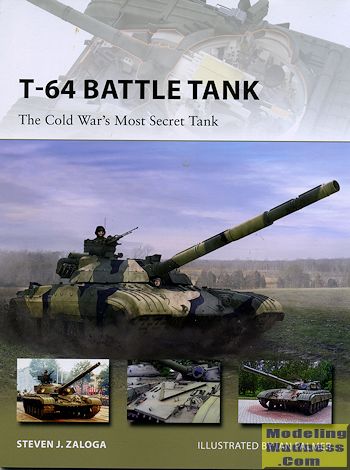 One of
the most influential Soviet tanks of the Cold War was the T-64. It was
originally developed as a medium tank to a requirement first put through in the
1950s as a counter to the American M-48 Patton. The idea was to provide a tank
with sufficient firepower and armor to be able to meet NATO tanks and come out
the victor. As is often the case in developing an all new weapon such as this,
the time from initial design until it was issued to the service was long and
went through a considerable number of changes from its original design.
One of
the most influential Soviet tanks of the Cold War was the T-64. It was
originally developed as a medium tank to a requirement first put through in the
1950s as a counter to the American M-48 Patton. The idea was to provide a tank
with sufficient firepower and armor to be able to meet NATO tanks and come out
the victor. As is often the case in developing an all new weapon such as this,
the time from initial design until it was issued to the service was long and
went through a considerable number of changes from its original design.
Most of us are fully aware that engineering and design are frequently
secondary to the needs of politicians and no where was this more prevalent than
in the Soviet Union. There was what the civilians wanted and what the Army
wanted. In this case, the civilian head wanted a revolutionary vehicle while the
army wanted something more conventional. Much of this difference surrounded the
engine. The army wanted a standard diesel engine while what they got was a light
weight 'boxer' style flat engine that was able to produce a considerable amount
of power, though it was notoriously unreliable. As is often the case, it took
years for the engine to reach its promised capabilities, but not before the tank
had already been issued to operational units. These units suffered from the poor
reliability of the engine for years before it finally reached maturity.
In the meanwhile, several other tanks were in development. One was the
T-72, which was quite conventional and the other was the T-80U, the Soviet's
first gas-turbine powered tank. This tank was notorious for its considerable
fuel consumption and was eventually built in fewer numbers than originally
planned before a diesel powered version entered production. Both of these tanks
were based on the development of the T-64 and it is only now that Russia has
developed a tank that is not based on this design.
The T-64 had everything a tanker would want in terms of firepower and
armor. It also had an autoloader that reduced the crew by one and allowed for a
smaller turret. The tank was upgraded in terms of equipment and weapons as the
years went by to meet the increases in equipment and armament of NATO tanks.
Even today, there are still T-64s being operated by ex-Soviet states. Such was
the secrecy surrounding the T-64 that it was not until the mid-1980s, years
after production had ceased, that the tank was first seen in public. It was
developed into a number of variations and while it only saw combat briefly, was
a mainstay of the Soviet Army in Germany until the dissolution of the Soviet
Union.
In this book, the author is able to untangle the often convoluted
mixture of politics and engineering that followed this vehicle through its
development and modifications. There are a considerable number of excellent
photos of this tank as well as some great illustrations of the tank in its most
recent deployment by the Ukraine Army in 2014. It is a book that I found to be a
great read and an important look at the development of a tank that helped form
the backbone of Soviet/Russian armor for decades.
September 2015
For more on the complete line of Osprey books,
visit http://ospreygrp.com. In the US, it is
Osprey Direct at 44-02 23rd St, Suite 219, Long Island City, NY 11101., where you can
get a catalogue of available books.
If you would like your product reviewed fairly and
fairly quickly, please
contact
the editor or see other details in the
Note to
Contributors.
 One of
the most influential Soviet tanks of the Cold War was the T-64. It was
originally developed as a medium tank to a requirement first put through in the
1950s as a counter to the American M-48 Patton. The idea was to provide a tank
with sufficient firepower and armor to be able to meet NATO tanks and come out
the victor. As is often the case in developing an all new weapon such as this,
the time from initial design until it was issued to the service was long and
went through a considerable number of changes from its original design.
One of
the most influential Soviet tanks of the Cold War was the T-64. It was
originally developed as a medium tank to a requirement first put through in the
1950s as a counter to the American M-48 Patton. The idea was to provide a tank
with sufficient firepower and armor to be able to meet NATO tanks and come out
the victor. As is often the case in developing an all new weapon such as this,
the time from initial design until it was issued to the service was long and
went through a considerable number of changes from its original design.